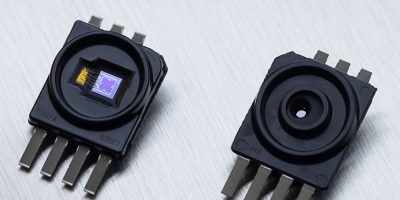Two relative pressure sensor IC provide “greener” ICE engine management
Two relative pressure sensor ICs with extended robustness to harsh media complete the PCB-less platform available from Melexis. The company claimed they are the most accurate pressure sensor ICs ever made. Customers and OEMs can use the pressure sensors to make internal combustion engine (ICE) engine management applications greener via a singular modular technology, said Melexis.
The MLX90823 (analogue output) and MLX90825 (digital Sent output) are relative pressure sensors which can be used in gauge mode (versus the atmospheric pressure) or in a differential mode (with two variable pressure levels). Unlike absolute pressure sensors, they measure the pressure difference between the two sides of the sensor. These factory-calibrated devices are intended to measure pressure spanning from 0.1 to 1.5 bar.
The pressure sensors fill the gap in accuracy performance in today’s automotive industry, according to Melexis. Access to stable and accurate data on pressure and temperature enables full lifetime engine management and helps OEMs reduce emissions on the last generation of ICE cars.
The pressure sensor family covers all the ICE management applications, including fuel vapour and crank case ventilation which ensures fuel vapours in the tank or gasses leaking through pistons are brought back into the combustion chamber.
They are also designed to reduce NOx emissions by sensing the amount of recirculated exhaust gasses in the engine intake and trapping the residual particulates in the exhaust filter.
For secondary air injection (SAI), the sensor enables a fast warm up of the catalytic converter with the secondary air injection.
The sensor is also designed to monitor the air going into the engine for accurately regulating the fuel and reduce consumption.
The MLX90823 and MLX90825 each consist of a sensor readout circuit, digital hardware, voltage regulators, Sent or analogue output drivers, and the essential passive components. A pre-calibrated (negative temperature co-efficient – or NTC – thermistor input is available for the MLX90825 (Sent output). Customers can interface the NTC through the pressure sensor without end-calibration.
Over-voltage (+40V) and reverse voltage (-40V) protection mechanisms are incorporated into the sensors’ design. Operating temperature ranges from -40 to +160 degrees C. They can even be exposed to 170°C temperatures for a short period, supporting downsized engine architectures, said Melexis.
The MEMS sensing element of the MLX90823 and MLX90825 consists of a micro-machined diaphragm etched into a silicon substrate. The diaphragm reacts to any pressure change that occurs. Piezo-resistive elements implanted into the diaphragm are configured to create a Wheatstone bridge that generates a signal. The accompanying front-end electronics subsequently amplify the signal and convert it into a digital format. The 16-bit DSP undertakes temperature compensation and the result is provided through a Sent or analogue output.
The MLX90823 and MLX90825 have been developed as a Safety Element out of Context (SEooC), in accordance with ISO 26262. They support ASIL B system integration for the MLX90825 (SENT) and ASIL A for the MLX90823 (analogue).




